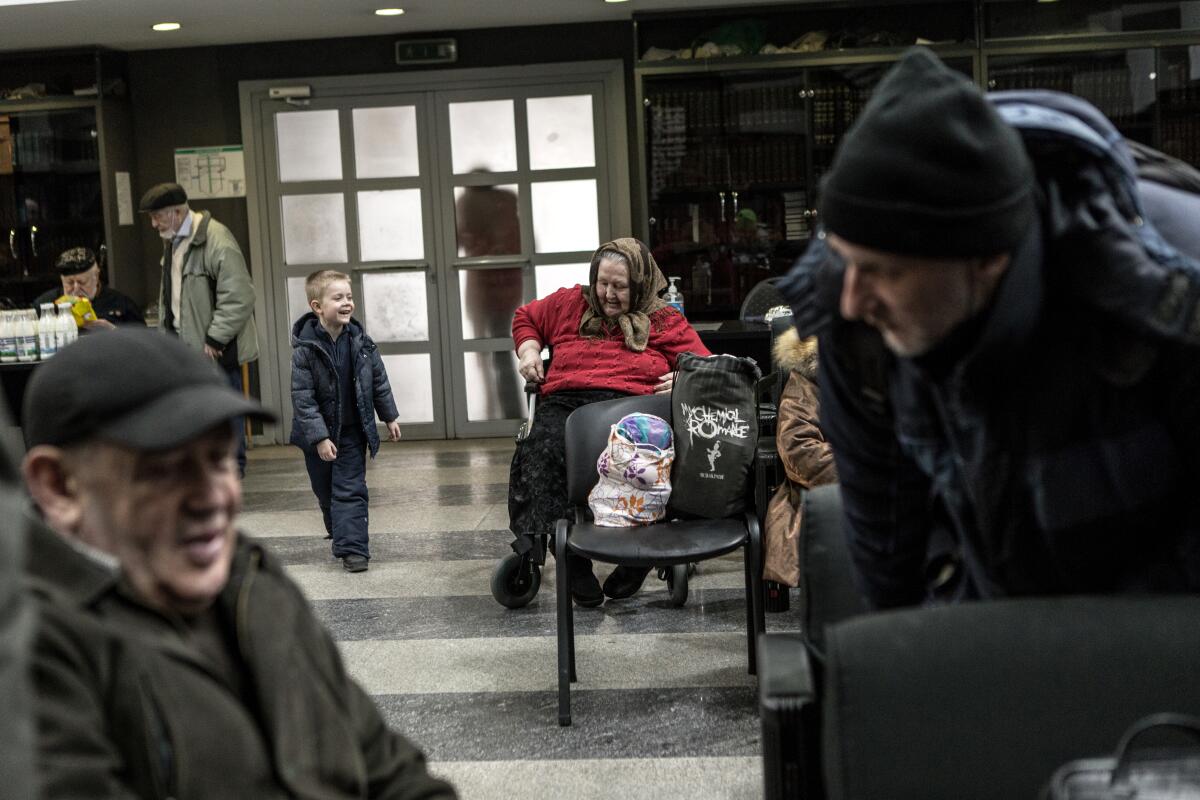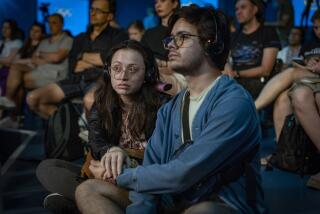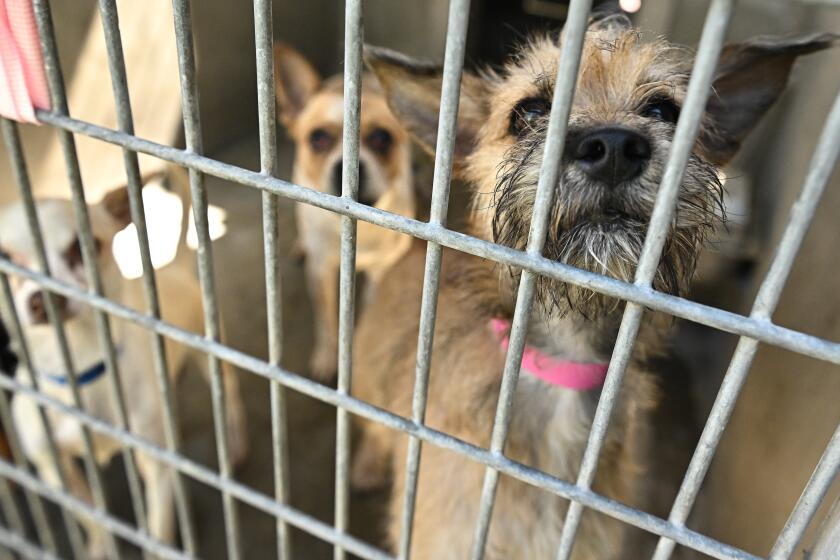Op-Ed: Ukraine can find inspiration from its resilient Jewish community

)
- Share via
There weren’t supposed to be any Jews left in Dnipro.
Not after Bohdan Khmelnytsky rallied the Cossacks 350 years ago to rise up against Poland and, along the way, to massacre the Jews. Ukrainians still celebrate him as a liberator and folk hero, displaying his statue in public squares and his picture on vodka bottles. Russians toast him for reuniting Ukraine with Mother Russia. But what Jews in that part of the world remember are stories of how “Khmel the Wicked” burned, beheaded or strangled their ancestors, denouncing them as footmen of Polish nobility. And how he burned their synagogues, except the holy Torahs, which his soldiers laid out in the streets to be trampled.
Adolf Hitler brought more advanced appliances of extermination to Dnipro, an isolated city of 1 million southeast of Kyiv. In October 1941, during the harvest festival of Sukkot, Nazi troops and Ukrainian police marched 11,000 Jews to a ravine on what is now the campus of the Dnipropetrovsk State University of Internal Affairs, then mowed them down with machine guns. A band played throughout to mask the screams. All told, 20,000 Jews were executed in the city during World War II.
The Soviets were subtler. Under their regime, Jews were identified as their own nationality — Jew — on their passports, which was supposed to signal that the communists accepted their religion and culture. In fact, the stamp set them apart, and the Kremlin drove home the message by shuttering 42 of Dnipro’s 43 synagogues. There was no effort to track down the hooligans who broke into the remaining shul during High Holiday services in 1963. In this era of tight state control over commerce and private life, there also was no kosher food, no bar mitzvahs, no circumcisions.
Then there were the Israelis, and to a lesser extent Americans and Germans. By opening their doors to immigrants after the Soviet Union fell 30 years ago, they unwittingly completed the displacement begun by the Cossacks, Nazis and Soviets. The opportunity to leave Dnipro was a godsend to nearly 30,000 Jewish Ukrainians who took it. It felt like a death blow to the Jewish community they left behind.
But there are still Jews in Dnipro. Thousands of them, some say tens of thousands.
Besieged by Russia’s weeks-long attack, Ukraine as a whole is counting on its own version of this story of improbable survival, of a community decimated but never erased. You can see it today in Dnipro, where many men proudly display their Jewishness with traditional beards and side curls, black hats and black robes, while women don sheitels and other traditional head coverings. Other Jews there blend in with their Slavic surroundings, yet take quiet joy in getting to know what it means to be Jewish.
Hundreds from both groups gathered this month at the elegantly restored Golden Rose Synagogue to celebrate Purim, the holiday that commemorates the saving of Jews from the murderous Haman. This year it carried a double meaning, with Russian President Vladimir Putin looming large as a threat to them and their country.
The city’s Jewish community is now sheltering Jewish and non-Jewish refugees from the shell-shocked metropolis of Kharkiv, the beleaguered port of Mariupol and other war-ravaged parts of Ukraine. That long-standing open-arms approach — enabled in part through a 30-year collaboration with their Jewish sister city, Boston — helps explain why Dnipro is hailed as the most thriving Jewish outpost in the former Soviet Union.
Despite another chance to escape to Israel or America, communal officials say most of the city’s Jews are not just remaining but defiantly resisting Putin’s month-old invasion and airstrikes against their city. What’s happening there is another lens into a Bible-worthy story of Ukrainians uniting behind their unlikely wartime leader, Volodymyr Zelensky, who is himself Jewish.
The seeds for Dnipro’s Jewish renewal were sown more than two decades ago, when I featured that city, then known as Dnipropetrovsk, in my book on the contemporary Jewish diaspora. Shmuel Kaminetsky, a Chabad rabbi born in Israel, rebuilt the local Jewish community according to a simple motto: Whatever it takes. Sometimes he borrowed, convincing 10 rabbis-in-training from Morristown, N.J., and Montreal to come to Dnipro for a year. Sometimes he charmed, such as when he persuaded Jews from Boston, London, Miami and elsewhere to commit millions of dollars to programs for the sick, the poor and the young in a city they barely knew, in a region the world had given up on. Sometimes he brokered, like when he secured medical treatment for a local crime boss in return for a hands-off policy toward Jews.
The miraculous results are visible today at the Menorah Center, a marble-clad collection of kosher restaurants, communal and religious buildings, a luxury hotel, and a youth hostel. Its boosters say that it is the largest multifunction Jewish complex in Europe.
Ukraine’s Jewish story has always blended the horrific and heroic. Consider what happened in the wake of the Khmelnytsky massacres in the mid-1600s. That brutality, and the savage Russian-Swedish war that followed, helped produce Sabbateanism, the largest messianic movement in Jewish history. The cycle repeated itself from the 1880s through the early 1900s, as violent pogroms encouraged Jews to launch Zionist and socialist organizations.
We’re witnessing an equally heroic effort now in Jewish Dnipro, turning tragedy into triumph — an effort that is inspiring the world as well as local residents, who are choosing to stay rather than emigrate.
Jews there tell a joke that captures the paradox of their repeating history. “When the last Jew leaves the city,” they say, “2,000 Jews will see him off.”
Larry Tye is the author of “Homelands: Portraits of the New Jewish Diaspora.” @larrytye
More to Read
A cure for the common opinion
Get thought-provoking perspectives with our weekly newsletter.
You may occasionally receive promotional content from the Los Angeles Times.










